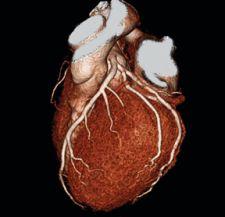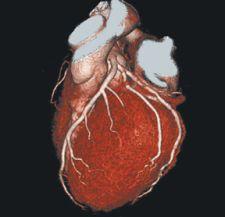
4D visualization is key to assessing cardiac function and perfusion studies.
The volatile debate over who should control cardiac imaging technologies - cardiologists or radiologists - has created a rift between the two fields. However, three physicians representing both fields are calling a truce on the turf wars by embracing the notion of greater collaboration. They believe this approach will optimize the potential of cardiac imaging.
Who is in Control?
Most physicians in both cardiology and radiology would agree that radiology initially developed most imaging techniques, but eventually lost control of these tools to cardiac clinicians. According to John Rumberger, M.D., Ph.D., director of cardiac imaging at Princeton Longevity Center, “Radiology had ultrasound of the heart, angiography, MRI and nuclear medicine in the beginning and one by one, they were usurped by the clinicians who were willing to take responsibility for the consequences of the imaging.”
From that point on, cardiology has dominated cardiac imaging. Representatives from these two fields of medicine do not expect to see this changing anytime soon. Reasons for this include the fact that cardiologists are the ones to make clinical decisions based on their qualifications and training. “I feel that this is a clinical test and should be interpreted by a clinician who is prepared to provide some insight as to what should be done with the patient. This is not about ‘differential’ diagnoses of some findings on a chest X-ray or a scan of the abdomen, but a commentary about the test results and clinical implications,” said Dr. Rumberger. “Generally, the cardiologists are more prepared to make clinical recommendations that they can then follow up—radiology is less prepared to make clinical recommendations, although this is not outside of their knowledge base.”
“In the end, the one who controls the patients will likely be the one to [dominate cardiac imaging],” he added.
According to both Dr. Rumberger and Michael Ridner, M.D., clinical director of The Heart Center, Huntsville, AL, radiologists are separated from the clinical arena as they read the scans and do not treat the patient.
“Radiologists do not know as much about the anatomy, pathophysiology, diagnosis and management of cardiac problems; therefore, their interpretations of cardiac tests lack consideration of the context of the patient,” according to Dr. Ridner.
Cross-Training Physicians
One of the challenges for radiologists may be a lack of training in invasive cardiac procedures, indicated Dr. Ridner.
“Cardiac CT involves much more complex patient preparation and data processing than a standard chest CT, which is outside the realm of a radiologist’s training,” said Dr. Ridner. “A vital component of CCTA (Cardiac Computed Tomography Angiography) is external correlation with invasive angiography, and many radiologists lack that training or access to these invasive angiograms.”
However, the lack of training can be appreciated on both sides of the debate as radiologist, Mark Herbst, M.D., Ph.D., president of St. Petersburg Independent Diagnostic Radiology Inc. in Florida, asserted that cardiologists do not know the “pitfalls that one might find in imaging.” He explained, “For example, I re-read a coronary CT that was read by a cardiologist first, but I didn’t know that. I looked at the scan, and determined that it was so full of artifacts from motion of the heart and breathing that the study was unreadable. It was worthless. One could not and should not say the coronary arteries were normal or abnormal from that study. Nevertheless, the cardiologist prepared a report calling one of the artifacts a severe stenosis.” Therefore, cardiologists may misinterpret findings due to not having sufficient training in radiology.
He also purports that cardiologists often times do not reveal relevant clinical histories of patients in order for a radiologist to make a more informed reading of a scan.
Dr. Herbst pointed out, “Cardiologists are not the only referring physicians who fail to include pertinent histories with their radiology consultations. People are busy, and I understand that. But you will note that when a referring physician sends his wife or mother or son to a radiologist for images, they are on the phone giving a complete history about where it hurts, how an injury happened, the previous surgical history, everything. All I wish is for physicians to treat their patients no worse than they would want their own family treated.”
Cardiac Imaging Specialists
All arguments aside, these physicians did agree that the value of what both radiology and cardiology bring to cardiac imaging is what really matters. Perhaps ironically, these physicians hope for a future of cardiac imaging in which both radiology and cardiology work more closely together.
Dr. Rumberger, who has worked as a cardiologist doing cardiac CT for the past 25 years, usually with only colleagues in radiology, believes that the best interest of patients would be served if both sets of physicians worked together.
Qualifications in training and ability are more important than who reads the scan, according to Dr. Rumberger. “Both radiology and cardiology bring much to the table,” he noted. “I believe that radiologists can be trained to make the decisions necessary for the recommendations following CTA and I believe that cardiologists are capable of knowing the nuances of imaging physics.”
Dr. Rumberger believes in the creation of a new profession, ‘radiac cardiologists’, in place of the almost vanishing profession of ‘cardiac radiologists’ so that the best interests of patients can be served. He added, “Working together, perhaps as cardiovascular imaging specialists with the requirements of both radiology and cardiology would be the best—a true imaging fellowship organization.”
Similarly, Dr. Ridner feels that CCTA is a hybrid technology that belongs to neither cardiology nor radiology and would fall more in line with the creation of a new specialty, which he would name “cardiac imaging specialist.” He believes that individuals conducting CCTA should be qualified on their own merits. “The two groups should work together to establish unified training for CCTA and management of cardiac patients. The clinical arena cannot be overemphasized; many times minor nuances in a patients’ history or exam will stimulate more scrutiny of a particular image. These concerns need to be shared across the two specialties. The development of a cardiac imaging specialist fellowship would be helpful.”
Resonating with Dr. Ridner’s vision, Dr. Herbst said, “I see cardiologists caring enough about their patients to reveal their histories to imaging experts so they might get the most out of the images. I see radiologists forgetting their egos and taking time from their pressured reading sessions to consider new findings that might have been missed without the details revealed by the clinicians. I think we will get there one day. I may not get there myself, but maybe our trainees will, and our trainees’ trainees will join each other, cable modem to wireless, face to virtual face, for the benefit of all of our patients.”
What’s the Hold Up?
Sentiments of collaboration may be well intended, but one of the major obstacles preventing greater cooperation between cardiologists and radiologists
is reimbursement.
Dr. Rumberger contended that some insurance forms only allow reimbursement to one party for all procedures or tests performed on a patient. Or, insurance companies have been known to charge the doctor for each of his or her patients referred for an out of insurance network test, even if the test would have been better performed by someone else. As a result, problems arise when two or more doctors interpret different parts of a single examination done on a patient. Issues regarding insurance companies dictating what a doctor can perform on a patient despite what he or she might like to do for the benefit of the patient also pose obstacles. Therefore, “many cardiologists will order the scan and self-refer,” said Dr. Herbst.
Dr. Rumberger added, “A lot of this is about preservation of lifestyle. Control is a major issue as this then relates to advancement and money. Do not think for a second that this is just about better patient care, although all of us think that this is the ultimate goal.”
Until some headway is made with insurance companies, it is likely that further
collaboration between the two fields will continue to be a struggle and the debate will go on.

